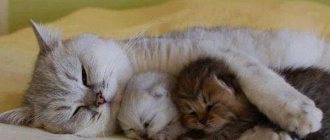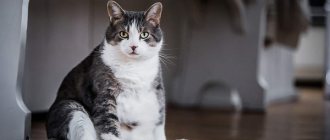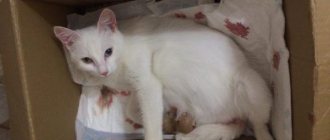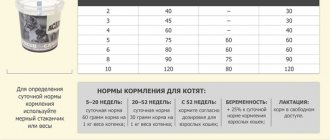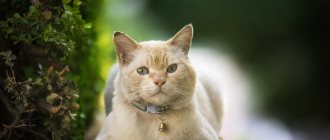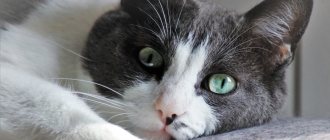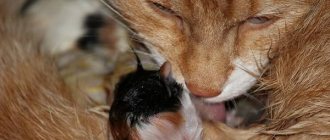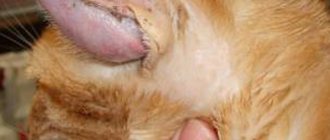General information
Cats, especially primiparous and old ones, become very tired and exhausted during childbirth. Rapid and shallow breathing immediately after childbirth (within a couple of hours after it) is a completely normal and physiologically justified phenomenon , so you should not worry about it too much. You need to start doing this in cases where the animal is hoarse and “puffs” intensely a few hours after the birth of the kittens. Most likely, this indicates some serious pathology.
Pregnancy leads to many anatomical and physiological changes in a cat's body. Many of these changes directly or indirectly affect the state of the cardiovascular system, which is not surprising: during pregnancy, it must work twice as intense. It is for this reason that any problems in the functioning of the heart and/or blood vessels, which the body could somehow compensate for in normal times, become pronounced.
Many pathologies of this period are characteristic only of pregnancy and in some cases can spontaneously “resolve” after the birth of kittens. Of course, this is not always the case. Disorders such as fluid embolism, pulmonary edema, and especially postpartum cardiomyopathy will not go away on their own. If you do not urgently provide highly professional assistance to the animal, it will almost certainly die soon after birth.
How to care for kittens if their mother abandoned them?
Please note that a cat who has gone into heat and has lost her milk will most likely abandon her kittens. Moreover, in the most unfavorable cases, she can simply eat them. If you want to save the babies’ lives, you will have to take on all the burdens of care. This applies not only to feeding: when raising cubs, you need to remember about numerous nuances, the observance of which determines both the health and life of the offspring.
First, examine the babies: remember that they are normally constantly moving and twitching, even when they have not yet learned to walk. If the kitten is not sleeping but looks lethargic and inactive, this is not good. In their sleep, kittens are quite calm and can practically not change the position of their body. When a baby is constantly spinning and meowing, it can mean two things: either it has some kind of health problem, or (more likely) it is very hungry.
In case you had to take on the responsibilities of a cat mother, make it a rule to examine your pets daily. Healthy young kittens have warm skin and small, round tummies (provided they are well fed). In addition, strong babies must have a strong, pronounced sucking reflex. As soon as you bring the nipple to their mouth, they immediately begin to draw milk from it. If there is no such reflex or it is poorly expressed, then the baby is very likely not viable. Of course, you can try to get out, but it is impossible to give any guarantee of success.
Postpartum cardiomyopathy
Postpartum cardiomyopathy is one of the most common postpartum pathologies of the cardiovascular system , the exact causes of which still remain unknown. This form of cardiomyopathy usually occurs in the second half of pregnancy. As we have already said, its exact predisposing factors are unknown, and therefore in many cases the disease is considered “idiopathic”.
Many veterinarians suspect that chronic arterial hypertension, mitral stenosis, obesity, viral myocarditis, preeclampsia, anemia, and infectious diseases (especially of a viral nature, since they hit the cardiovascular system hard) may be indirectly to blame.
The incidence of postpartum cardiomyopathy is highly variable. In many situations, clinical signs may well subside some time after birth and not appear until the next pregnancy. In these cases, we can talk about mild damage to the ventricles of the heart. Alas, in more severe situations, the only thing that can save a cat is a heart transplant, which, for obvious reasons, is impossible.
Sometimes it is possible to increase the life expectancy of an animal through well-chosen drug treatment, but one should not particularly hope for its success. To some extent, only timely diagnosis and a competent veterinary cardiologist can improve the prognosis. We hasten to reassure the owners of sick cats to some extent: with high-quality treatment and sterilization (which is highly recommended), your pet will most likely live a long and happy life. But only in cases where you contact your veterinarian on time.
Clinical picture and diagnosis
As a rule, sick animals develop a clinical picture characteristic of typical cases of congestive heart failure. It may include: shortness of breath, cough, tachypnea and cyanosis (blue discoloration of all visible mucous membranes). In addition, the development of edematous phenomena (especially in the lower abdomen), sharp swelling of the jugular vein, as well as weakening of the sounds of heart contractions during auscultation are characteristic.
Ultrasound or fluoroscopic examination often reveals a severe increase in the size of the heart (cardiomegaly). When diagnosing, pathology should be differentiated from pulmonary thromboembolism, pneumonia, amniotic embolism and asthma.
To do this, take into account the following features of the disease:
- When clinical signs appeared - before, immediately after, or within several weeks (months) after the birth of kittens.
- No other causes of heart failure.
- Presence/absence of other heart and vascular diseases before pregnancy.
Very often, cardiomyopathy leads to the development of pulmonary edema . It is caused by poor blood circulation in the pulmonary circulation. When the blood has nowhere to go, its liquid fraction under pressure begins to gradually leak into the pulmonary alveoli.
Signs of edema are quite characteristic: the cat constantly sits with its mouth open, a loud and hoarse bubbling sound comes from the chest, all visible mucous membranes quickly turn blue. Flaky, white foam may be released from the mouth.
If such symptoms appear, the animal must be urgently taken to the nearest clinic, as otherwise it will suffocate.
Therapeutic techniques and important notes
Treatment of cardiac cardiomyopathy in cats is only symptomatic and medicinal. It is no different from therapy in cases of “normal” heart failure. Oxygen masks, a diet with minimal Na and Cl content are indicated, diuretics and vasodilators are prescribed.
How and what to give to kittens if their mother has not started lactation?
In ideal cases, it is necessary to find another nursing cat and “throw” new cubs at her . In this case, you need to take a “donor” litter kitten and carefully wipe the foundling on it. Otherwise, the cat will not accept a baby that smells like another animal.
Important! You can feed babies ONLY with a special substitute intended specifically for kittens. The use of cow's and goat's milk for these purposes is not allowed.
Their composition is radically different from that of cats, and therefore the use of such “ersatz” often leads to severe diarrhea. The latter, as you know, is deadly for small kittens! Babies can die from dehydration within hours.
What brands of “baby food” can I use to feed kittens? In our country, they are produced by famous manufacturers, such as Royal Canin, Beaphar, Canina.
Considering that they are not found in every pet store, it is advisable to consult with a veterinarian in advance. When using such tools, remember the following:
- You can find both liquid and powdered substitutes on sale, and the latter, as you might guess, must be diluted with boiled, settled and warm water before use. As a rule, it is necessary to comply with the same requirements and recommendations as in the case of baby food (i.e., it must be diluted thoroughly, without lumps, the temperature of the finished mixture is within 37-38° Celsius.
- Remember that there are milk formulas on sale intended for feeding adult cats. Such mixtures are ordinary skim cow's milk, from which all lactose has been additionally removed. Diverging slightly from the topic, we note that such food does not bring any particular benefit to adult cats (nor does it cause any harm). It can be given to kittens only in extreme cases, when there are no other options. Moreover, this should be done no more than two or three times, while searching for more suitable food for them.
Let's assume that you don't have milk or formula. What else can you give kittens? Experienced veterinarians say that babies can be given thick rice water . Of course, there are not enough nutrients there, but this thick jelly will allow the kittens to fill their tummies and fall asleep. At this time, you can also find a suitable milk formula for them.
The cat is acting restless and not eating anything
Many owners wonder why a cat after giving birth does not want to eat anything and behaves restlessly. And everything is very simple. After the birth of kittens, the animal develops a maternal instinct, and if someone is constantly near her and her offspring, then the cat will not only eat nothing, worrying about her kids, but may even go to the toilet on the carpet in that the room where she is located.
A cat may feel fine after giving birth, but may need help from its owner.
Cats love silence and privacy, so you need to move it with the kittens to a secluded place or cover their box with some kind of sheet and not open it.
For your information! There is no need to visit them every five minutes, because the cat may even show aggression.
This behavior is a completely normal reaction aimed at the protection and health of its offspring.
When does milk appear after kittens are born?
Owners are not always able to determine the problem and the degree of its complexity. When a female is pregnant, the volume of her mammary glands increases, and if pressure is applied to them, a translucent discharge is noticed. Some cats release colostrum immediately after she gives birth. A healthy female who has given birth should begin to produce milk immediately; sometimes the process is delayed for 1-2 days. At this time, kittens drink colostrum, which is also nutritious and necessary for babies.
Veterinarians note that a cat that has given birth for the first time may not produce milk for 3-5 days after the birth of kittens. This situation is the norm and is more often recorded in artificially bred breeds.
The cat is breathing heavily after giving birth
In general, childbirth in cats is much easier and faster than in dogs, but sometimes there are exceptions. For example, if a cat often breathes with its mouth open after giving birth, this indicates a number of serious health problems, so you should immediately seek medical help from a veterinarian.
Important! After childbirth, breathing may be rapid, but not more than 15 minutes. If shortness of breath with an open mouth occurs much longer, then you should start sounding the alarm.
Reasons for frequent shortness of breath may include:
- inflammatory process in the mammary glands;
- the presence of a dead fetus in the uterus;
- delayed delivery of the placenta;
- eclampsia.
A cat's heavy breathing that continues for a long time should alert you.
If a delay in the release of the placenta has been diagnosed, then after conservative treatment it will come out in the form of lochia for several days, but if not, then surgical intervention is performed.
For your information! The presence of a dead fetus is very dangerous for the animal.
In this case, the cat may not survive, so surgery must be performed immediately.
How can you tell if your kitten is hungry and not getting enough food?
Insufficient lactation in a female can be determined by the weight of the cubs.
If a female gives birth for the first time or repeatedly and her milk has disappeared, then the owners are not always able to immediately recognize the problem. When babies constantly meow and behave restlessly, you should immediately check the cat’s mammary glands by pressing on them. If milk is not produced or it comes in a small trickle, then you should contact a veterinary clinic. Other signs help to understand the development of the problem:
- The cat's reluctance to be near kittens. A female who has difficulties with breastfeeding more often abandons her offspring or stays near the babies reluctantly and for a short time. But not all cats exhibit this behavior; other individuals may continue to stay close to the kittens, try to feed them and care for them.
- Weighing babies regularly. If a cat produces milk in small quantities, then there is not enough milk for all the offspring, which is why the babies grow slowly and gain weight. Regular weighing helps to understand the development of the problem. If the female is healthy and lactation is normal, then the kitten gains more than 10 g per day.
When babies go hungry and don't get enough milk, they experience a decrease in body weight. The table shows approximate standards that the owner needs to follow:
| Age, months | Weight, gram |
| One month old kitten | 500—750 |
| 2 | 1000—1500 |
| 3 | 1700—2300 |
| 4 | 2500—3600 |
| 5 | 3100—4200 |
| Six months | 3500—4800 |
It is recommended to pay special attention to the color of the milk. When it turns yellowish or pinkish, this may indicate an inflammatory reaction in the cat's mammary gland, and immediate medical treatment is required.
Postpartum cat care
After a cat has given birth on its own, few people know how to properly care for it. For 12 days after giving birth, small blood clots may still ooze from the cat’s vulva, but the animal takes care of its hygiene on its own. Gradually the discharge will become lighter and stop altogether.
Note! If the animal is sick or has given birth for the first time, then the owner will have to care for her. You need to take a warm, damp towel and wipe the vulva, abdomen and thighs to remove dirt.
From time to time it is necessary to change the dirty litter under the kittens and the cat with clean ones. This should be done when the mustachioed mother has gone to the toilet or gone to eat, so as not to disturb her again. If you are constantly near the offspring, then she may begin to hide the kittens in another place where it is more secluded.
It is important to monitor the condition of the mammary glands so that they are not inflamed or cracked, because as any disease progresses, the offspring will have to be supplemented by hand.
The cat takes care of the kittens, but if it is weakened, then the owner will have to take on some of the worries.
Comfort zone
A cat that has become a mother should feel safe, so it is better to place it away from drafts in a separate warm room, where strangers and small children will not enter. At first, the pet takes any approach with hostility: it strives to protect its offspring, so it can hiss at everyone who approaches it. Try not to disturb the cat during the first days: place the tray and bowls in the same room so that the animal does not have to go far from the kids.
Give the mother and offspring a large box, lay out fresh diapers made of smooth fabric, and if necessary, give the kittens an electric heating pad. If your cat is meowing and fussing around the box, one of the kittens may have fallen out of the nest or become tangled in the diaper and will need your help.
Nutrition during the postpartum period
After giving birth, it is necessary to give the animal milk, cottage cheese and sour cream, that is, foods rich in calcium. If the body does not have enough of this element, then the pet’s general health may deteriorate, convulsions and postpartum eclampsia may appear.
A cat should eat a variety of foods: meat, fish, chicken eggs. An important source of vitamins is greens, which should also be finely chopped and added to food. If the animal refuses to eat it, then there is no need to force it in, but it is better to purchase special vitamin complexes at the pharmacy.
Nutrition for a mustachioed mother is especially important during this period
For your information! You should definitely increase the amount of fluid you drink. The cat should drink water and also eat soups, broths, etc. The two meals a day should be increased to six times and given in small portions so that the cat has regular milk production.
Recovery period
Since pregnancy and childbirth take a lot of energy from an animal, the recovery period will be long. During this time, many minerals and vitamins are lost, which can result in spinal curvature and spinal deflection.
Pregnancy also has a negative impact on reproductive health, causing the cat to constantly experience hormonal changes. All this greatly depletes the animal, so you need to be patient, monitor proper and balanced nutrition, and then the pet will quickly recover.
Important! Often after giving birth, a cat begins to ask for a cat again, but this should not be allowed; the animal must be provided with peace in order to gain strength and health.
Signs of labor in a cat
In order not to miss the onset of labor, owners carefully observe how the cat behaves before giving birth:
- a few weeks before lambing, you can easily notice the enlargement of the mammary glands;
- 1-2 days before the important moment, colostrum is slowly released;
- unusual behavior of a cat is difficult to ignore: this is the search and arrangement of a “nest”, changes in mood, anxiety, desire to hide, or extraordinary affection;
- drop in body temperature to 37°;
- appetite may disappear completely;
- The cat often licks the genitals.
The main thing is to let the pet feel that she is not alone: talk to her tenderly, pet her, arrange a House for her in a secluded corner.
What to do if maternal instinct is violated
Maternal instinct in cats may not begin to manifest itself in cats from the first days, especially if she is a primigravida. Also, stress, hormonal and genetic disorders are the cause of poor maternal instinct.
In addition, after a caesarean section, the instinct of motherhood may manifest itself weakly or not at all. Very often the person is to blame for this, because after giving birth he is constantly near the kittens, pushing them out of the box, making noise, picking them up, etc. This should not be done under any circumstances.
A set of measures to prevent undesirable consequences of childbirth
When preparing for childbirth, even experienced animals experience fear and anxiety. The nervousness of the cat's mother can negatively affect the birth process.
You need to observe the animal unobtrusively, trying not to disturb
To reduce the likelihood of complications, it is necessary to prepare in advance for your pet a place that meets the following requirements:
- Accessibility for cleaning. You need to be able to clean the cat’s “nest” and at the same time disturb the mother and offspring as little as possible. A good option would be a mattress covered with an absorbent diaper.
- Space limitation. While crawling, newborns can fall off the bedding, and the kitten’s squeak unnerves the pet. If labor is not completed, the reaction to the baby's crying can cause complications. A large box or installation of limiting sides will do.
- No drafts. The immunity of both mother and cubs is still weak.
- Removing strangers. Extra people make the animal worry and try to hide the born offspring. Inexperienced cats can accidentally crush babies. In a calm environment, the pet will relax, give birth and settle down so that it is more convenient for newborns to suckle.
Be sure to read:
Can a cat give birth to one kitten if the fetus is in the birth canal, what to do?
A cat giving birth should have a bowl and a toilet next to the “nest”. The birth process can take several days and the cat's mother needs to ensure that her natural needs are met.
Postpartum discharge in cats and care for it
Nature allowed 10 days for complete recovery. Features of this condition:
- discharge lasts from 7 to 21 days;
- When kittens suck milk, the uterus contracts;
- The first discharge is brown or red, but gradually becomes transparent.
What to do during this period:
- In general, the cat takes care of itself, but if you notice stuck pieces of blood in the thigh area, you need to take a wet napkin and wipe it;
- keep the box clean by regularly changing the bedding;
- place the cat and its offspring in a closed place to avoid a stressful situation.
Discharge in cats after birth
Symptoms of eclampsia
A postpartum complication called eclampsia can occur not only in cats, but also in other warm-blooded animals. The following behavioral features of the cat will help determine that your pet has this particular complication :
- Breathing problems, shortness of breath. It becomes difficult for the animal to breathe.
- Feverish trembling, elevated temperature.
- Cramps and muscle spasms.
- The behavior becomes strange, the animal constantly rushes around the room, trying to hide in a dark place.
© shutterstock
In the most difficult cases, even eating the offspring is possible. With each passing hour, when the animal becomes ill, it becomes worse: salivation appears, the cat constantly falls on its side, and suffers from muscle spasms. After a few hours, he becomes inactive and lethargic, and loses interest in kittens.
Dangerous discharge from a cat
If oxytocin was used during labor and the discharge is bright red, then this 100% means tissue rupture, which is a threat to the pet’s life and requires immediate assistance from a veterinarian.
If the discharge is thick with green spots, then this indicates inflammation of the walls of the uterus as a result of infection or incomplete release of the placenta. In this case, treatment with antibiotics or surgery is prescribed.
Discharge of yellow and gray colors means inflammation of the uterus. The disease is dangerous. A high temperature rise occurs, the cat begins to hide, meows heavily and, if inactive, ends in death.
Note! If the affected area is large, the uterus must be removed.
Complications during childbirth
In the first days, the owner needs to examine the nipples and monitor the nature of the vaginal discharge in order to notice pathological abnormalities in time.
Some animals calmly give birth in the presence of the owner, while others try to hide in a secluded corner. If the pet is hiding, then it cannot be left unattended.
Your cat may need help with the following conditions:
- Weak labor. This happens due to a large fetus or weakness of the uterine muscles.
- Bleeding. Appear when the birth canal or uterine walls are damaged. Veterinarian assistance should be provided within 10 minutes.
- The birth of a kitten in the amniotic sac. Usually the bladder ruptures inside the uterus, but if it comes out intact, then you need to break the membrane and give the baby to the mother. If this is not done, the kitten may die.
You need to observe the animal unobtrusively, trying not to disturb it. If the cat trusts the owner, then she herself asks for help with a loud meow.
Prevention of complications
To avoid health complications, it is necessary to provide proper care for your cat in advance: clean diapers, boiled water and cotton swabs. It is very important to find a place for lambing, especially if it is a Scottish cat who does not like when any of the people are nearby, he begins to meow and look for a secluded place.
Before giving birth, it is imperative to feed the animal correctly and in a balanced manner so that it is strong and healthy, and then the birth will be quick and easy. It is important to remember that kittens must be born in a sterile environment so that the infection does not penetrate the uterus and cause complications for the new mustachioed mother.
In most cases, cat birth occurs without any complications. But it also happens that during the birth process, unforeseen circumstances arise that threaten serious complications, both for the animal and for the future kittens. Unlike other pets - dogs, cats do not use their tongue to increase the area of evaporation and regulate body temperature. If a cat frequently breathes with its mouth open after the end of the birth process, this may indicate serious problems with the health of the animal and requires immediate attention to a veterinarian.
Feeding and drinking a nursing cat
To prevent problems with milk in a cat, you must follow a number of rules. First of all, organize complete and sufficient feeding of the expectant mother. In the last period of pregnancy and during lactation, the cat is fed ad libitum; in other words, it should receive as much food as it can eat.
There is no need to worry about your pet gaining excess weight - the energy costs of milk production are such that this does not threaten the nursing mother.
Drinking is of particular importance for normal milk production - this is understandable, since along with milk, not only nutrients and biologically active substances leave the mother’s body, but also a large amount of liquid.
Clean, fresh water should always be near the “nest”. In addition, you can give your cat wet food in addition to dry food or dietary broths cooked with lean meat.
Causes of rapid breathing after childbirth
Childbirth is a rather difficult and dangerous period of life for a cat, because the birth canal can become infected with various pathogenic microorganisms or be injured. After the end of normal labor, the cat breathes rapidly for 5-15 minutes . If rapid breathing continues for much longer, you should consult a doctor as soon as possible. Due to the fact that the animal may experience complications. The animal may breathe frequently after birth due to severe stress.
Other dangerous complications with increased body temperature are:
- retained placenta;
- unborn dead fetus inside the uterus;
- inflammation of the mammary glands;
- eclampsia.
Characteristic changes during the rehabilitation period of a cat after childbirth depend directly on how the birth process went. An important recommendation is to contact a veterinarian immediately after the cat has given birth to kittens. This is necessary to monitor the condition of the animal and exclude possible pathological conditions.
Note! In the first week after birth, it is necessary to monitor the cat’s body temperature. Measurements are taken once a day. A rise in temperature above 39.5 degrees is a reason to contact a veterinarian.
Dead fetus or retained placenta
The first sign of this pathological condition is an increase in temperature, restless behavior of the cat and dragging of kittens. The animal often breathes with its mouth open and refuses to eat. It is important to monitor during the birth process, and it is best to record how many kittens were born and the number of afterbirths released. An alarming sign if one of the placentas does not come out.
Important! It is worth remembering that an ultrasound examination does not always give a positive result. The fact is that the uterus is enlarged after childbirth and may contain blood clots, which are mistaken for a failed placenta.
When diagnosing retained placenta, conservative treatment is carried out, including the use of medications. After treatment, the placenta comes out in the form of lochia over several days. In certain cases, surgery is used.
A dead fetus in the uterus is another dangerous complication that can lead to death for the animal . The fetus is removed surgically after conservative methods have not yielded positive results during the first 24 hours after the cat gives birth.
Mastitis
A type of complication affecting the mammary glands and ducts. This pathology is expressed in the form of severe thickening of the mammary glands, their redness and soreness. It occurs due to infection of the milk lobes through microcracks in the nipples as a result of bruises, blows or scratches.
Due to an increase in body temperature, the cat begins to breathe rapidly, trying to normalize heat exchange. In addition, one of the signs of mastitis in a cat is upset stool in young animals. Such a complication can develop against the background of hormonal imbalance, severe hypothermia and a weak sucking reflex in newborn kittens. If you notice stagnation of colostrum, blood impurities, or a change in milk thickness, you should consult a qualified doctor for advice.
Eclampsia (milk tetany)
One of the most dangerous pathological conditions in a cat, occurring during the period before childbirth or immediately after it. This acute nervous process is caused by a lack of an important trace element in the blood - calcium. A sharp decrease in calcium can cause seizures in cats. Eclampsia develops after childbirth and during lactation. Very rarely, eclampsia may appear several months after birth.
- The main symptoms of eclampsia in cats are:
- rapid breathing;
- fear and anxiety;
- convulsive phenomena;
- jaw clenching;
- neck stretching;
- foamy discharge from the mouth.
In the process of bearing kittens, the cat’s body spends enormous reserves of calcium. If there is a lack of calcium in the body of a pregnant cat, stable calcium is used, located in the bone structures. This process is called calcium leaching.
Treatment is carried out exclusively under the supervision of a veterinarian. For therapy, medications are used that stabilize the exchange of calcium ions between bone structures and blood, increase the activity of the organic component of the bone base and increase the interaction of calcium with the cells of bone structures.
The owner's attentive attitude to the condition of his pet and timely prevention of consequences will help maintain the health of the cat and small kittens. It is necessary to monitor the general condition of the new mother and her offspring not only in the first hours after birth, but also for several weeks after. If your cat has a fever, increased breathing, fear or anxiety, you should contact a veterinary clinic.
Lack of stress as a risk reduction method
From the moment of fertilization until the end of feeding the offspring, the body of the expectant mother is under stress. Any stress, but especially prolonged and monotonous stress, depresses the animal’s immune system and creates health risks. How to protect your cat from additional stress?
The first and most effective method is pregnancy planning. To register a mating, you need to contact the breed club and submit documents confirming the breeding value of the animal. Mating is carried out after confirming the authenticity of titles, selecting the optimal partner and obtaining permits.
After receiving the documents, both parents are examined by a veterinarian. The doctor must give a conclusion that the cats are healthy and do not have genetic pathologies. At least 3 weeks before mating, revaccination courses must be completed and preventive measures taken to eliminate parasites in both parents. After the cat comes into heat, the animals are mated and, if successful, the mating is registered as successful.
This whole scheme may seem complicated, but it is the only reliable method that will ensure that you do not harm your pet and get healthy kittens. Now let's get back to everyday life, how do cats usually get mated? Without preparation or without the knowledge of the owner. In this case, at the time of pregnancy, the cat may be affected by worms, which will have a detrimental effect on both gestation and the viability of the kittens after birth.

